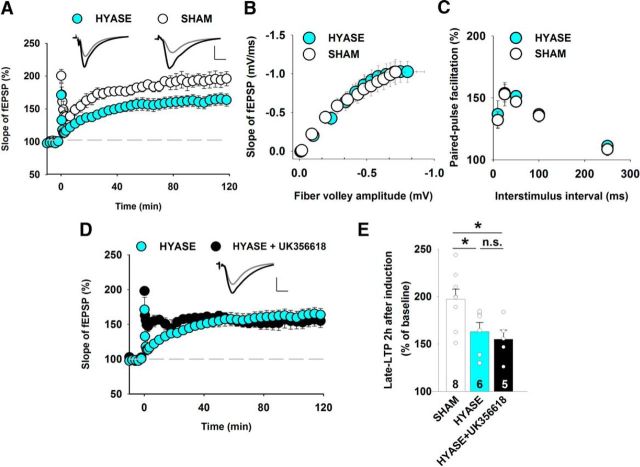Figure 10.
Digestion of hyaluronic acid occludes the impact of MMP-3 inhibition on LTP in the CA1. A, Digestion of hyaluronic acid with hyaluronidase decreased the magnitude of LTP that was induced by 100 Hz tetanus (sham: 197 ± 11%; hyaluronidase: 163 ± 10%; t test, t(12) = 2.10, p = 0.041). B, C, Digestion of hyaluronic acid in hippocampal slices using hyaluronidase did not affect the input–output relationship or short-term plasticity in the CA3-CA1 projection. B, Average initial fEPSP amplitudes recorded at CA3-CA1 synapses in slices that were treated for 2 h with hyaluronidase (filled circles, n = 12) and respective controls (open circles, n = 14), plotted against the fiber volley amplitude. The statistical analysis was performed using two-way ANOVA followed by Bonferroni correction, revealing no differences between genotypes (comparison of fiber volley amplitude: F(1,312) = 0.11, p = 0.74; comparison for fEPSP slope: F(1,312) = 0.089, p = 0.77). C, Treatment with hyaluronidase did not affect short-term plasticity, assessed by paired-pulse facilitation, at various interstimulus intervals (n = 6 sham-treated slices, n = 13 hyaluronidase-treated slices; t test between genotypes, p > 0.48 for all interstimulus intervals). D, The hyaluronidase-resistant component of LTP was unaffected by the MMP-3 blocker UK356618 (0.8 μm; hyaluronidase+UK356618: 155 ± 10%; t test vs hyaluronidase, t(9) = 0.58, p = 0.57). E, The statistical analysis of LTP that was induced by 100 Hz HFS showed that UK356618 occluded the effects of hyaluronidase treatment. *p < 0.05. n.s., not significant.

